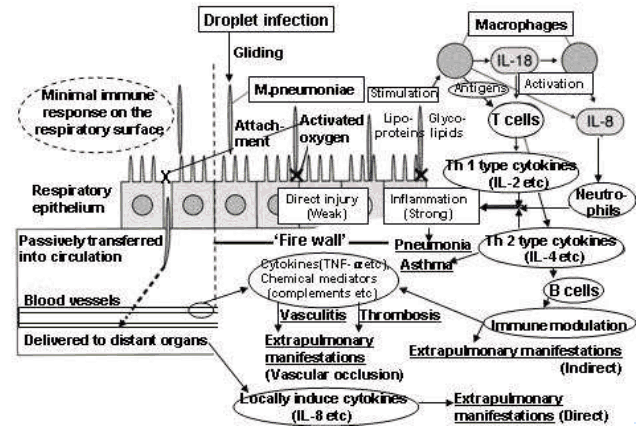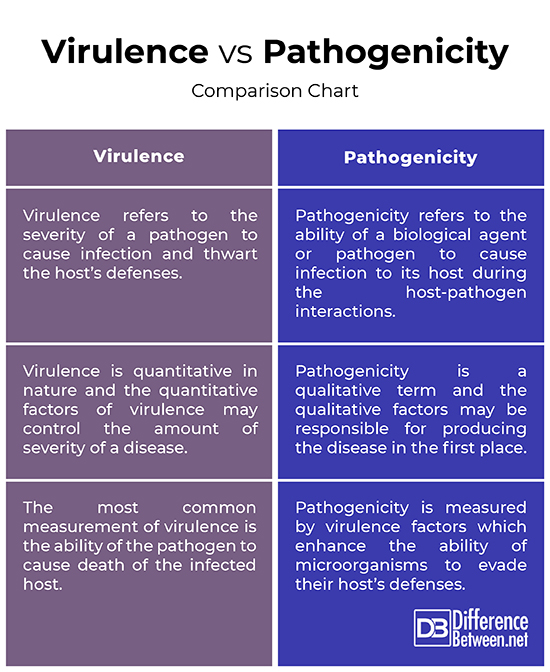Difference Between Virulence and Pathogenicity
In the eyes of microorganisms or any biological organism, the human body is one big ecosystem that comprises of a variety of environmental factors to thrive on and it seems they are custom-made to suit their needs. This ecosystem is everything they need to grow and evolve. As humans have evolved as species, so have the pathogens. Over time, they have gained or lost genetic traits that would allow them to adapt to any environment, or more importantly, allow them to thwart the evasive measures of the immune system. These can have serious implications on human body. In some cases, the pathogens gain enhanced virulence factors that allow them to cause disease more effectively. Pathogenicity is the ability of the pathogens to infect thxeir host.

What is Virulence?
The severity of a pathogen is entirely dependent on its ability to survive, reproduce, and infect a new host. Sometimes the host builds new defenses to thwart the pathogen’s attack, but the pathogen is so strong that it creates a more effective strategy to penetrate through the defenses of the host. Evolutionary fit pathogens can survive, replicate and spread effectively within the host and they generate the ability to passing their genes on to the next generation. This heightened ability of a pathogen to thwart the defense systems of a host is termed as virulence. So, virulence is the ability of a microorganism or pathogen to infect a host. Simply put, virulence refers to the severity of a pathogen to cause infection. For example, when we say Ebola is highly virulent, it means it is highly contagious and is very difficult to contain, especially in urban environments. In fact, it is considered as one of the most virulent pathogens which is capable of transmission even after the death of the host.

What is Pathogenicity?
Pathogenicity is defined as the ability of a biological agent or pathogen to cause infection to its host during the host-pathogen interaction whether intentionally or accidentally. While virulence refers to the degree of severity of pathogens to infect its host, pathogenicity is defined as the pathogen’s ability to infect its host. It is somewhat related to virulence but is rather distinguished as a qualitative term. These infections can be classified as local, focal or systemic, based on extent to which the pathogen spreads in the body of a healthy individual. It refers to the pathogen’s capacity to cause a disease. Some pathogens might develop enhanced virulence factors which allow them to more effectively cause disease. Simply put, the quality of a microorganism to inflict damage to its host can be termed as pathogenicity. So, the qualitative nature of pathogenicity only makes sense in the context of host-pathogen interactions.
Difference between Virulence and Pathogenicity
Definition
– Both the terms are often used interchangeably in the context of microbial harmfulness and the interactions between the host and the microbial world. Pathogenicity refers to the ability of a biological agent or pathogen to cause infection to its host during the host-pathogen interactions. Simply put, pathogenicity determines whether a pathogen is capable enough to inflict damage to its host. Virulence, on the other hand, is the degree of pathology caused by the pathogen, meaning it refers to the severity of a pathogen to cause infection and thwart the host’s defenses.
Nature
– Virulence is defined as the relative ability of a pathogen to infect its host. Thus, virulence is quantitative in nature and the quantitative factors of virulence may control the amount of severity of a disease. Pathogenicity, on the other hand, is a qualitative term and is absolute for a specific pathogen and its host. And the qualitative factors, on the contrary, may be responsible for producing the disease in the first place. But, the quantitative measurement of virulence and the qualitative nature of pathogenicity only make sense in the context of host-pathogen interactions.
Measurement
– Pathogenicity depends on the host-pathogen relationship which in turn, depends on the virulence of the pathogen and the relative degree of the ability of the host to build defenses against the pathogen. Pathogenicity is measured by virulence factors which enhance the ability of microorganisms to evade their host’s defenses. The pathogens which are highly virulent are more likely to evade the host’s defenses and infect them. Virulence has been measured in many ways, but the most common is the ability of the pathogen to cause death of the infected host. A simple measurement of virulence is the measurement of lethal dose required to kill half of the infected hosts, commonly referred to as LD50.
Virulence vs. Pathogenicity: Comparison Chart

Summary of Virulence and Pathogenicity
The ability of the pathogen to evade the immune system defenses and infect the host is significant factor associated with the development of infection. The target mechanisms of virulence and pathogenicity make sense because they have the potential to render pathogens susceptible to host defense systems without killing them. Pathogenicity is the ability of a pathogen to cause infection to its host, whereas virulence is the relative ability of a pathogen to infect its host. The quantitative factors of virulence may control the amount of severity of a disease, and the qualitative factors of pathogenicity may be responsible for producing the disease in the first place.
- Difference Between Caucus and Primary - June 18, 2024
- Difference Between PPO and POS - May 30, 2024
- Difference Between RFID and NFC - May 28, 2024
Search DifferenceBetween.net :
Leave a Response
References :
[0]Groisman, Eduardo A. Principles of Bacterial Pathogenesis. Cambridge, Massachusetts: Academic Press, 2001. Print
[1]Russell, Wayne and Heiko Herwald. Concepts in Bacterial Virulence. Basel, Switzerland: Karger Publishers, 2005. Print
[2]Sansonetti, Philippe. Bacterial Virulence: Basic Principles, Models and Global Approaches. New Jersey, United States: John Wiley & Sons, 2010. Print
[3]Dobrindt, Ulrich et al. Between Pathogenicity and Commensalism. Berlin, Germany: Springer, 2014. Print
[4]Kudva, Indira T. et al. Virulence Mechanisms of Bacterial Pathogens. New Jersey, United States: John Wiley & Sons, 2020. Print
[5]Johnson, Douglas I. Bacterial Pathogens and Their Virulence Factors. Berlin, Germany: Springer, 2017. Print
[6]Image credit: https://commons.wikimedia.org/wiki/File:Pathogenicity_of_Mycoplasma_pneumoniae_in_vasculitic-thrombotic_disorders.png
[7]Image credit: https://commons.wikimedia.org/wiki/File:H_pylori_virulence_factors_en.png
